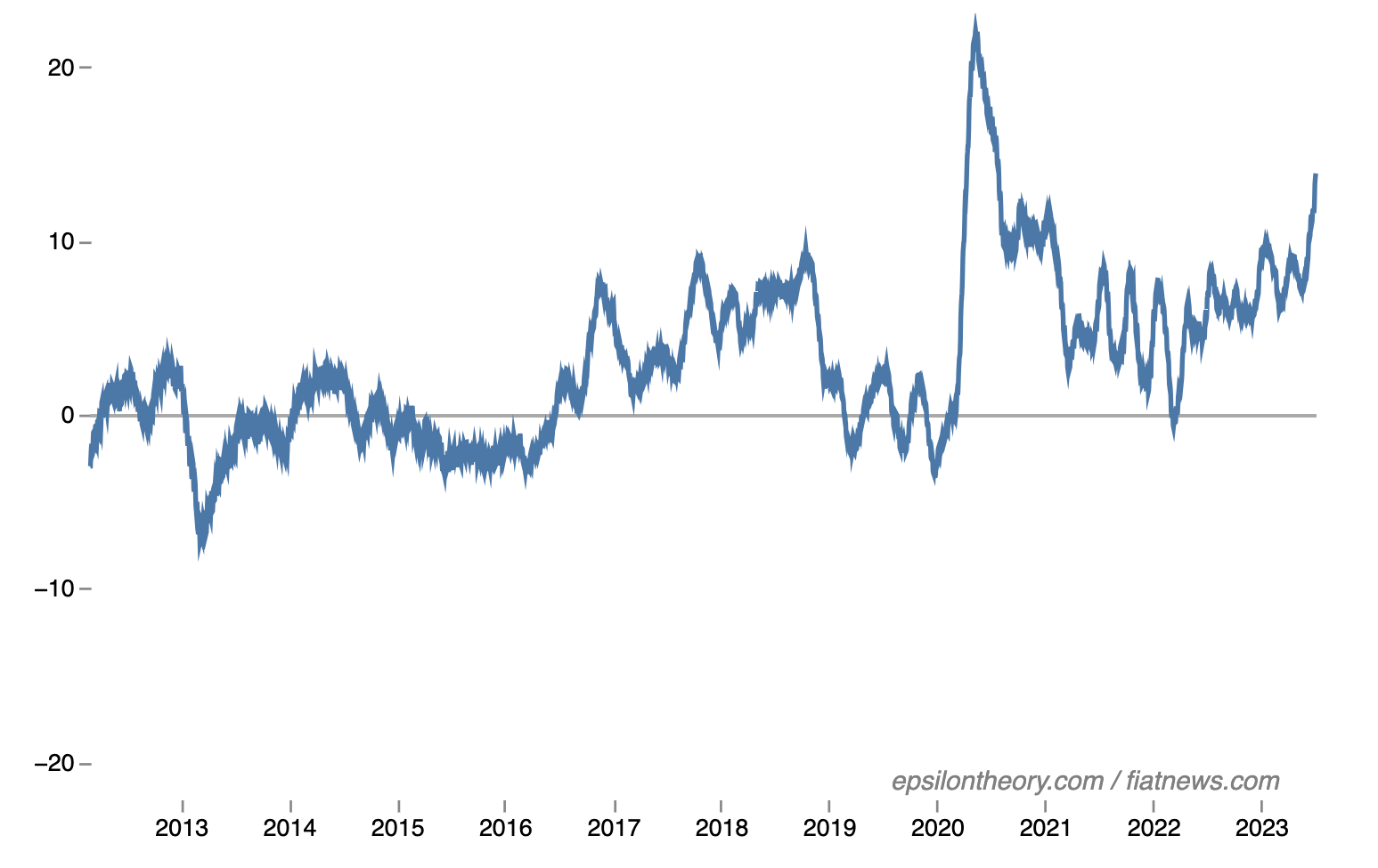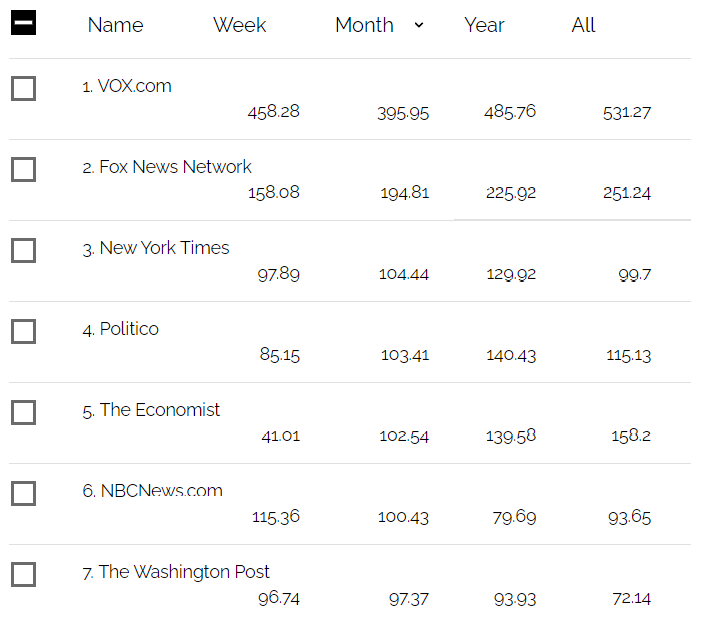
Today we are thrilled to announce the official launch of FiatNews.com.
We are launching it in beta, by which we mean that we think there is so much more that we can do with the tools and datasets we have built. We want to hear from you. We want to know what topics we can track. We want to know about visualizations and combinations of the data presented that would be more useful to you. We want to know what we can do to deliver this to you in a useful way. Got a thought? Email us at info-at-epsilon-theory-dot-com any time. Or, if you prefer, mercilessly harass Ben on Twitter (@epsilontheory).
For those of you who know the drill on Fiat News, feel free to head over to FiatNews.com to check it out.
But because many of you may be new to what we are talking about, allow me to reintroduce the concept of fiat news, walk you through our methodology for quantifying it, and illustrate what kind of information the current dashboards can provide. If you want the original, in-depth essay on the concept, it is located here. If you want a subsequent piece that highlights the development of our thinking on the best ways to quantify and measure Fiat News, you can find it here.
But for the shorter and more practical version, stick around.
What is Fiat News?
Like most of you, we are concerned about the information we consume. We are concerned about what happens to a society that does not appear to be operating from a shared set of facts. We are concerned about the extent to which institutions and algorithms have adopted paternalistic, Nudging tendencies, guiding us toward the Correct Way to interpret the events of the world.
Like many of you, we have found that the medicines that have been promoted thus far are often worse than the diseases they purport to cure.
Fact-checking, for example, can be useful for identifying outright and obvious falsehoods. Full-hearted people checking the statements of politicians, executives and other public figures for accuracy often perform a very real service to expand our shared set of facts. We think the fact-checking genre as practiced, however, more often produces new forms of information uncertainty. In practice, we observe unevenness among practitioners in selecting which statements to check for facts, the frequent imposition of opinions about “context” that should be taken into account, and even the remarkable phenomenon of fact-checking statements with material misstatements of facts of their own.
Likewise, bias monitoring of outlets is a minefield. We think there are full-hearted people in the business of bias checking, whether formal or informal, who mean well. But qualifying “bias” means also qualifying some normative level. That invariably makes bias checking a sort of Wittgenstein’s Ruler, an exercise in which it is unclear whether we are at any point measuring the bias of a news outlet or the bias of the bias checker. That’s why there are now fact-checker checkers.
Fiat news is not the same thing as fake news. Fiat news is not the same thing as bias.
Fiat news is the presentation of opinion as fact.
FiatNews.com tracks the density of language strongly related to the expression of an opinion.
We like this method for a couple reasons.
The first, and probably most important, reason is that we think that fiat news is far more widespread than fake news. We also think it can be vastly harder to detect with the naked eye.
We also think our approach is less likely to produce the problem it seeks to solve. Don’t mistake me. It is not perfect. Any language model will be biased by its construction and its training, at least in a technical sense. That’s part of the reason we are calling this a beta launch. We will be updating and improving these models, testing them for both false positives and false negatives over time. But on political and tribal dimensions, we think simply measuring opinion-expressing language is inherently far closer to neutral.
The long-term goal of FiatNews.com is simple. We want citizens to know when someone is trying to tell us how to think.
How do we track Fiat News?
FiatNews.com tracks the density of opinion language used in the largest English-language newspapers, websites, news and opinion journals, and blogs against twelve language models. Each represents one of the main ways we believe that authors influence the reader’s response to English-language news.
Appeals to Authority: Generic references to individuals often used to enhance the credibility attached to a preferred point of view of the other (e.g. “Experts say”, “Scientists agree”, etc.). To be distinguished from explicit references to such parties (e.g. “A team at Cambridge University found”, “Dr. Johnson said”) that represent standard reportage on many beats.
Asking Questions: The imposition of unasked questions on the reader, a mechanism for guiding the reader on the questions they should be asking. As simple as identifying news articles with constructions like “Why is this happening?” or “What happens next?”
Bogeymen: The conjuration of well-known loaded references (e.g. “Hitler-like”) to produce obvious emotional affect in the mind of the reader.
Conditionality: Heavy use of the subjunctive mood or other linguistic mechanisms which either impose uncertainty or facilitate the author’s use of hypotheticals.
Confidence and Doubt: Use of language, often in adjective or adverb forms, which has the effect of intentionally increasing confidence or doubt in a statement or claim (e.g. “dubious claims”, “obviously”, “certainly”, “vague”).
Covering the Response: News coverage which seeks to frame a topic or event around the social media and news coverage response to the event.
Explicit Missionary Language: Language which literally tells the reader how to think (e.g. “This is how to think about this,” or “Here’s what you have to understand.”)
Generalized Attribution: References to aggregated groups that seek to create a perception of popularity or sensibility around a communicated claim or idea (e.g. “Most people think”, “Everybody knows”).
Implied Cause and Effect: Language indicating the presumption of a causal link between two statements or events (e.g. “As a result”, “Because of this”), or else the juxtaposition of two events for the purpose of eliciting the presumption of a causal link in the reader (e.g. “Markets fell as investors reacted to X”).
Interpretive Language: Language which shows an attempt to transform an event or fact into an interpretation of what it means. A subtler form of Explicit Missionary Language (e.g. “A disappointing result”, “surprising outcome”).
Unsourced Attribution: The use of anonymous sources.
Use of Superlatives: Extreme word choice or use of words with embedded moralization (e.g. “unprecedented”, “unfathomable”, “evil”).
We aggregate these measures and then recut them across subsets of our news dataset. For now, those subsets include (1) high-level topics and (2) outlets. In the future, we anticipate adding (3) companies and other institutional entities, as well as (4) public figures and (5) emerging news stories. We have tentative plans to make the tools and models with which we evaluate individual articles available in extension or app formats to permit the evaluation of individual pieces of news or other content on Fiat News dimensions.
How do I read FiatNews.com?
First, by recognizing that the presence of fiat news language is not necessarily bad. Opinions are not necessarily bad. Our language models will produce false positives, and even when they produce a true positive, that doesn’t mean the outlet is doing a Bad Thing.
In all cases, our indexes, sub-indexes, outlet-level statistics and topic-level statistics are normalized against a baseline for our entire news dataset. In other words, when you see aggregated fiat news density, what you’re seeing is how much more or less dense with that language that index, outlet or topic’s content has been relative to the general tendency of our news dataset.
Let’s look at an example.
The chart below shows our headline Fiat News Index. This represents all topics and outlets within our dataset for the period between January 2012 and today. It aggregates the density of all twelve categories of fiat news language into a single measure. The value shown is an index that should be read as the percentage difference from normal levels. The end of this chart means that the aggregate level of opinion-leading language in our news dataset is 13.7% higher than its baseline. It peaked at more than 20% during the COVID pandemic.

For these and all other measures, each value is based on a 60-day rolling period. That means that a value at any point is telling you about the fiat news content of the last two months. That is also true for our other headline measures, including this one, which provides figures relative to history broken down by category. The number represents a percentage difference in the density of language within that particular category relative to the long-term average.

You can navigate from headline indexes to topics and outlets by using the three tabs located at the top of the page. Within each of the “By Outlet” and “By Topic” tab, you will find data that is initially sorted in descending order by the one month period. That is, the top-most outlet and topic on each page, respectively, will represent the outlet and topic that has demonstrated the highest absolute level of fiat news language over the last month. By clicking on any period in the headers on the left side of the page, you can change the period over which it is sorted, and whether it is done so in ascending or descending order.
The figures here mean what they mean elsewhere. The fiat news language density of what Vox has published this month is 396% higher than that of the long-term tendency of our full news dataset. Fox News and the New York Times are right behind them.

By selecting “Relative”, you can see the tendencies of each outlet or topic relative to their own history. Again, figures reflect percentage differences in fiat news language density. In the last month, AFP has published content with 27% more fiat news language than their long-term baseline. That doesn’t mean that they have a high fiat news content relative to other outlets, simply that they seem to be in a period where this language is elevated.
In case you are reading this at a later date, this is the zeitgeist in France, where the AFP wire service is based, over the last month. This is precisely the kind of use case we see for our method.

By checking one or more topics or outlets, you can create visualizations on the right side of the page which show that outlet or topic over various periods of time. Those periods can be selected on the top of the right-hand side of the page. If you want to compare different topics or different outlets, you can select up to 10 at a time for these visualizations.
FAQs
What is the difference between “Relative” and “Absolute?”
Absolute charts compare a topic or outlet to a baseline of the full universe. That means that any value you see corresponds to a percentage difference in the density of fiat news language from that outlet or topic relative to the full universe.
Relative charts compare a topic or outlet to its own history. That means that any value you see corresponds to a percentage difference in the current density of fiat news language relative to that outlet or topic’s historical tendency.
Are the big sources all here? What’s missing? How did you pick the Fiat News 40?
Our dataset consists of a very large cross-section of the most shared, most circulated news outlets, blogs and non-traditional media sources. We are missing a couple of what we think are key sources, mostly on the basis of their extreme cost: Bloomberg News and Financial Times.
The Fiat News 40 was our effort to deliver a consistent, manageable slice of the most important such sources, being sure to include a collection of different types of outlets (e.g. magazines, newspapers, blogs, journals). While the site does rank the Fiat News 40 on our various measured dimensions, the selection to the Fiat News 40 in the first place does not reflect the quantity or density of opinion language. It simply reflects our opinion about the most important US-oriented English-language news sources likely to be encountered on social media.
Some of the sources don’t seem to be available for the full period when I look at them on the Sources tab.
Our news dataset is assembled from a variety of sources and vendors. For some sources and outlets, data further in the past is not always available. For others, our analysis indicates that the vendor’s data for that outlet in a given period was incomplete. When in doubt about the completeness or accuracy of an outlet’s content for a given period, we will err on the side of caution.
That said, we continue to look to expand our sources, outlets and the length of time for which data is available.
Is this AI or ChatGPT-driven?
No. We use GPT-4 to help speed the development of our language models in various ways but none of the output should be thought of as the output of an AI model.
[Outlet] seems to have a much higher/lower Fiat News density than I would have expected.
Remember that the online, published news content of many outlets, especially those associated with television brands, is often very different in nature. Likewise, there are many outlets (e.g. New York Post, other tabloids) which make heavy use of headline writing and social media blurb editing to sensationalize otherwise dry body text. Still other sites with heavy opinion brands rely on low fiat news density newswires to produce much of their other content.
Still, if you see something that seems out of range, we’d love to know what you’re seeing.
Can I see [Outlet X]?
Maybe! If you think there are other outlets that deserve a closer and more regular look, let us know.
Are you excluding explicit opinion and Op-Ed content?
No! We feel strongly that the graying of the lines between opinion and news content – especially around specialty desks, feature articles and investigative journalism – is one of the biggest ways in which fiat news is propagated. We have consistently found practically zero bright line or step change in opinion language in official opinion content vs. what is represented as being hard news. So for the many outlets which do not adequately note content as being opinion or analysis, we’d almost certainly be creating apples-to-oranges issues with the ones who do.
We also think that the expansion of the volume of explicit opinion content is a major feature of a transition in how “news” is done that needs to be quantified. We think the fiat news calculations help to do this as well. The counter-argument would be, I think, that this might affect whether we are actually tracking the relative opinion language density in news coverage across outlets. With the exceptions of the major opinion journals (e.g. Vox, for which we would expect high fiat news ratings without animus – they are what they say they are!), we do not see enough opinion / op-ed content or enough differences in the volume of that content among comparable publications to feel that it detracts from the applicability of our measures.
What do I have access to?
The headline Fiat News indices – everything on the first tab – is accessible via a free subscription. Our topic- and outlet-level indices are accessible via the standard Epsilon Theory Premium subscription with no additional cost.
As we roll out additional features, including individual companies, public figures, narrower topics and other more detailed analyses, this is subject to change.
Can I score and measure individual articles?
Not yet. But soon.
Our general thinking is that the best way to do that is through a browser extension that would highlight areas in articles that the reader should pay attention to on account of high fiat news language density.
Can I post these images or stats elsewhere?
Headline indexes you can post whenever and wherever you like. Just don’t pass it off as your own.
For things behind a paywall, anything’s fine to share with friends, family and colleagues. If you want to republish to a larger network as a one-off, just reach out to us. It’s almost certainly not going to be a problem. We want these ideas out there.
I’m a content producer and am interested in using this as a tool to monitor opinion-creep. Can we do that?
Pretty soon, yes. And once we can, we’ll happily partner with you on that project at zero cost. Our goal isn’t to antagonize the news media. For those whose business models permit it and share our vision, we want to be an ally to a return to dry, fact-based news.
Do you guys have a political bias?
LOL. Of course we do. We’re humans. Our team has political views, mostly on opposite sides of the spectrum. We can’t and won’t promise who we are won’t bleed into our words and our work. What we will promise is that we’re doing our absolute best to design a systematic framework where there are as few ways for that to happen as possible.









